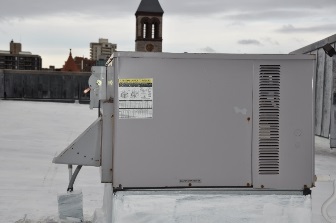
HVAC controls
Heating, ventilating, and air conditioning (HVAC) systems use 40-60% of the total energy consumed in buildings, according to the U.S. Department of Energy. HVAC systems heat, cool, and ventilate a building to maintain proper airflow, air quality, and overall comfort conditions for its occupants. Prism installs cost-saving HVAC controls, including variable frequency drives, demand controlled ventilation, EC motors and controls, and economizers.
Variable frequency drives
Variable frequency drives (VFDs) are designed primarily to optimize the speed of a motor. Motors that power pumps and fans will run at full speed regardless of whether or not the mechanical system component requires full power to operate. VFDs vary the motor speed based on system feedback, so only the actual power needed is consumed. Varying the speed optimizes the energy consumed to eliminate wasted energy and costs.
A cubic relationship exists between the reduction in motor speed and the energy the motor consumes, according to affinity laws. For example, if the speed of a motor is reduced by 15 percent, the motor horsepower is reduced by 45 to 50 percent. In some instances, a VFD can save 50% of the energy required to perform an operation. Other benefits of a VFD include:
- Reduced fan noise
- Reduced electric demand (kW)
- Reduced wear and tear
- Reduced maintenance
- Power factor correction
- Soft start
Demand controlled ventilation
A demand controlled ventilation (DCV) system adjusts the amount of fresh air that is brought indoors based mainly on the number of occupants within a room or space. Ventilation is important for buildings to prevent air quality issues from excessive carbon dioxide (CO2), odors, and off-gassing (trapped gas in materials and furniture). DCV deploys CO2 sensors in return air ducts to measure CO2 levels against predetermined set points. When CO2 levels rise above the prescribed setpoint, controls are triggered, opening air dampers or commanding fans to bring in and circulate additional fresh air until CO2 levels are reduced sufficiently. Without DCV, most buildings need to be ventilated with constant airflow, regardless of the building’s occupancy level.
Fresh air introduced into a building needs to be heated or cooled, depending on the season, to maintain comfort conditions for occupants. Conditioning more air than necessary results in a great deal of wasted energy. Conversely, monitoring CO2 also ensures that ventilation occurs as necessary to satisfy building code requirements and to maintain comfort conditions. A DCV system can reduce energy use for this specific measure between 30-50% with typical paybacks of less than 2 years.
Commercial and industrial sectors that benefit the most from a DCV system include:
Electronically commutated (EC) motors and controls
EC motors are designed to significantly reduce the power output of smaller horsepower motors for equipment such as unit ventilators, exhaust systems, walk-in coolers, or walk-in freezers. Evaporators in a refrigeration unit, for example, have either a 1/20 or a 1/15 horsepower induction motor running the fans. An induction motor is inefficient compared to a direct current (DC) motor. EC motors are a type of brushless DC motor that provide the same horsepower as an induction motor, but at a fraction of the electrical draw. Savings of up to 65% are possible by simply replacing the motor.
For refrigeration, EC motor controls can be added to reduce energy consumption further. Without controls, motors will run at full power constantly. By adding EC motor controls, the motor will run only when the thermostat calls for a cooling cycle. By monitoring the inlet and outlet temperature of the coolant, the fan speed can be turned up or down, depending on the setpoints.
HVAC economizers
An HVAC economizer system will sense the inside and outside air temperatures. If the temperature of the air outside the building is cool and dry enough to utilize for air conditioning, the economizer will turn off the compressor and utilize the outside air. This process can reduce energy use for this specific measure by up to 30% annually with a typical payback of 1-2 years.




